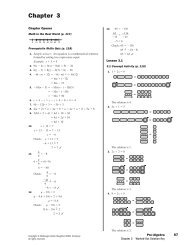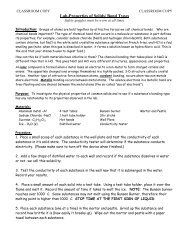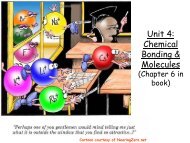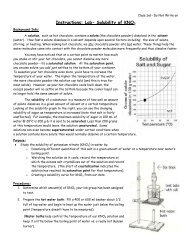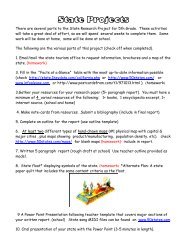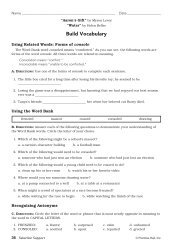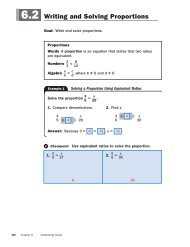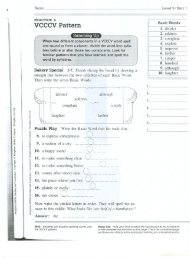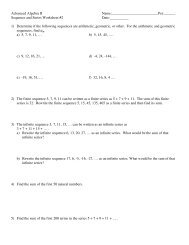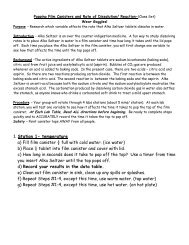PHASE CHANGES
PHASE CHANGES
PHASE CHANGES
Create successful ePaper yourself
Turn your PDF publications into a flip-book with our unique Google optimized e-Paper software.
9-7. Solve problems involving heat flow and temperature changes, using<br />
known values of specific heat (q= m ●c ● Δ T) & latent heat of phase<br />
change (q= m Δ H). (CSS: 7d)<br />
<strong>PHASE</strong> <strong>CHANGES</strong>
Phases of Matter
Phases of Matter<br />
Solid Liquid Gas<br />
•Motion of particles is<br />
restricted (only<br />
vibrational)<br />
•Particles are more<br />
closely packed<br />
•Lowest kinetic energy<br />
•Strong intermolecular<br />
forces<br />
•Have definite volume<br />
•Particles are in constant<br />
motion<br />
•Lower kinetic energy<br />
than gas particles<br />
•Attractive forces<br />
between particles effect<br />
their behavior<br />
•Particles are not fixed,<br />
but are closer together<br />
than in a gas<br />
•Particles are in<br />
constant, rapid motion<br />
•Highest kinetic energy<br />
state of matter<br />
•Attractive forces do not<br />
effect their behavior<br />
•Particles are far apart
Phase Change Names<br />
“Fusion”<br />
“Vaporization”
Why phase changes require heat<br />
energy<br />
Heat is required for phase changes because it<br />
breaks/ weakens the attraction between<br />
molecules.
ΔH = Change in Heat (aka Enthalpy)<br />
∆H fusion = “Latent Heat of<br />
Fusion”<br />
• heat required to melt or<br />
freeze a substance<br />
• +ΔH = melting<br />
(endothermic)<br />
• ─ΔH = freezing<br />
(exothermic)<br />
∆H vaporization = “Latent Heat<br />
of Vaporatization”<br />
• heat required to vaporize<br />
or condense a substance<br />
• +ΔH = vaporization<br />
(endothermic)<br />
• ─ΔH = condensation<br />
(exothermic)
Phase Diagram (water)
Heat = Temperature<br />
As you can see from the graph (plateaus) , it is possible to add<br />
heat to water, but see no temperature change.<br />
Two things can happen when you heat a substance:<br />
1) The substance can experience a raise in temperature. That<br />
is, the heat can be used to speed up the molecules of the<br />
substance.<br />
2) The substance can change state. Although heat is absorbed by<br />
this change of state, the absorbed energy is not used to speed<br />
up the molecules. The energy is used to change the bonding<br />
between the molecules.
Latent Heat of Fusion (Δ H Fus ) for<br />
Water<br />
• Amount of heat (q) required to change a mass (m) of a<br />
substance from a solid to a liquid or liquid to a solid:<br />
Energy (J or cal)<br />
q = m ·Δ H Fus<br />
Mass (g)<br />
“Latent Heat of<br />
Fusion”<br />
(J/g or cal/g)<br />
Δ H fus water = + 334 J/g<br />
Δ H fus water = - 334 J/g
Latent Heat of Vaporization for<br />
Water<br />
• Amount of heat (q) required to change a mass (m) of<br />
a substance from a liquid to a gas or gas to a liquid:<br />
q = m ·Δ H Vap<br />
Δ H vap water = + 2260 J/g<br />
Δ H vap water = ─2260 J/g
Fusion and Vaporization for Water<br />
q= mΔ H vap= +/- 2260 Joules/ g<br />
q= m Δ H fus = +/- 334 Joules/ g<br />
For (a- b) (c-d) & (e-f) on graph<br />
use : q = m · c · Δ T<br />
To find energy needed to raise temperature
Sample Problem: How much heat in KJ is required to<br />
change 50 grams of ice at -10 C to a liquid at 40 C?<br />
3<br />
2<br />
1<br />
Step 1: Find heat it takes to raise ice from -10 ° C to 0 ° C (q = m · c · Δ T)<br />
q= (50g) (4.18 J/g ° C ) (10 ° C ) = 2090 J<br />
Step 2: Find heat to do a phase change from solid- liquid (q = m Δ H Fus)<br />
q = (50 g) (334 J/ g) = 16700 J<br />
Step 3: Find heat it takes to raise temp from 0 ° C to 40° C (q = m · c · Δ T)<br />
q= (50 g) (4.18 J/g ° C ) (40 ° C )= 8360 J<br />
Total (add steps 1+2+ 3)= 27150 J or 27.150 KJ





